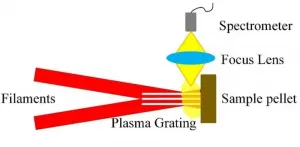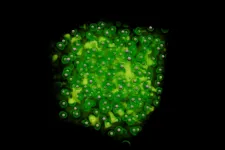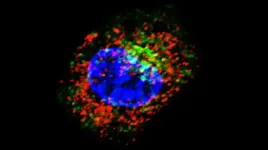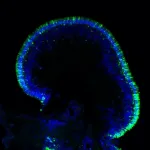Thick lithosphere casts doubt on plate tectonics in Venus's geologically recent past
2021-01-28
(Press-News.org) PROVIDENCE, R.I. [Brown University] -- At some point between 300 million and 1 billion years ago, a large cosmic object smashed into the planet Venus, leaving a crater more than 170 miles in diameter. A team of Brown University researchers has used that ancient impact scar to explore the possibility that Venus once had Earth-like plate tectonics.
For a study published in Nature Astronomy, the researchers used computer models to recreate the impact that carved out Mead crater, Venus's largest impact basin. Mead is surrounded by two clifflike faults -- rocky ripples frozen in time after the basin-forming impact. The models showed that for those rings to be where they are in relation to the central crater, Venus's lithosphere -- its rocky outer shell -- must have been quite thick, far thicker than that of Earth. That finding suggests that a tectonic regime like Earth's, where continental plates drift like rafts atop a slowly churning mantle, was likely not happening on Venus at the time of the Mead impact.
"This tells us that Venus likely had what we'd call a stagnant lid at the time of the impact," said Evan Bjonnes, a graduate student at Brown and study's lead author. "Unlike Earth, which has an active lid with moving plates, Venus appears to have been a one-plate planet for at least as far back as this impact."
Bjonnes says the findings offer a counterpoint to recent research suggesting that plate tectonics may have been a possibility in Venus's relatively recent past. On Earth, evidence of plate tectonics can be found all over the globe. There are huge rifts called subduction zones where swaths of crustal rock are driven down into the subsurface. Meanwhile, new crust is formed at mid-ocean ridges, sinuous mountain ranges where lava from deep inside the Earth flows to the surface and hardens into rock. Data from orbital spacecraft have revealed rifts and ridges on Venus that look a bit like tectonic features. But Venus is shrouded by its thick atmosphere, making it hard to make definitive interpretations of fine surface features.
This new study is a different way of approaching the question, using the Mead impact to probe characteristics of the lithosphere. Mead is a multi-ring basin similar to the huge Orientale basin on the Moon. Brandon Johnson, a former Brown professor who is now at Purdue University, published a detailed study of Orientale's rings in 2016. That work showed that the final position of the rings is strongly tied to the crust's thermal gradient -- the rate at which rock temperature increases with depth. The thermal gradient influences the way in which the rocks deform and break apart following an impact, which in turn helps to determine where the basin rings end up.
Bjonnes adapted the technique used by Johnson, who is also a coauthor on this new research, to study Mead. The work showed that for Mead's rings to be where they are, Venus's crust must have had a relatively low thermal gradient. That low gradient -- meaning a comparatively gradual increase in temperature with depth -- suggests a fairly thick Venusian lithosphere.
"You can think of it like a lake freezing in winter," Bjonnes said. "The water at the surface reaches the freezing point first, while the water at depth is a little warmer. When that deeper water cools down to similar temperatures as the surface, you get a thicker ice sheet."
The calculations suggest that the gradient is far lower, and the lithosphere much thicker, than what you'd expect for an active-lid planet. That would mean that Venus has been without plate tectonics for as far back as a billion years ago, the earliest point at which scientists think the Mead impact occurred.
Alexander Evans, an assistant professor at Brown and study co-author, said that one compelling aspect of the findings from Mead is their consistency with other features on Venus. Several other ringed craters that the researchers looked at were proportionally similar to Mead, and the thermal gradient estimates are consistent with the thermal profile needed to support Maxwell Montes, Venus's tallest mountain.
"I think the finding further highlights the unique place that Earth, and its system of global plate tectonics, has among our planetary neighbors," Evans said.
INFORMATION:
[Attachments] See images for this press release:
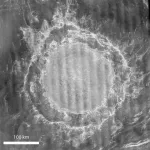
ELSE PRESS RELEASES FROM THIS DATE:
2021-01-28
BOSTON-Boston Medical Center has released a study that shows post overdose outreach programs in Massachusetts have expanded across the state, as 44 percent of municipalities reported having such programs available - a majority established since 2015 - to reduce risks for those who survive an overdose. The results are published online in the February 2021 issue of Drug and Alcohol Dependence.
These post-overdose outreach programs leverage collaborations between public health overdose prevention practitioners and public safety organizations (police, fire, EMS) to engage overdose survivors and/or their social networks (family, friends, and acquaintances) at their home one to three days after an overdose. ...
2021-01-28
Laser-induced breakdown spectroscopy (LIBS) is a rapid chemical analysis tool. A powerful laser pulse is focused on a sample to create a microplasma. The elemental or molecular emission spectra from that microplasma can be used to determine the elemental composition of the sample.
Compared with more traditional technology, like atomic absorption spectroscopy and inductively coupled plasma optical emission spectroscopy (ICP-OES), LIBS has some unique advantages: no sample pretreatment, simultaneous multi-element detection, and real-time noncontact measurements. These advantages make it suitable for practical analysis of solids, gases, and liquids.
Traditional LIBS and extensions
Traditional ...
2021-01-28
The study of warm dense matter helps us understand what is going on inside giant planets, brown dwarfs, and neutron stars. However, this state of matter, which exhibits properties of both solids and plasmas, does not occur naturally on Earth. It can be produced artificially in the lab using large X-ray experiments, albeit only at a small scale and for short periods of time. Theoretical and numerical models are essential to evaluate these experiments, which are impossible to interpret without formulas, algorithms, and simulations. Scientists at the Center for Advanced Systems Understanding (CASUS) at the Helmholtz-Zentrum Dresden-Rossendorf (HZDR) have now developed a method to evaluate such ...
2021-01-28
With a powerful enough light, you can see things that people once thought would be impossible. Large-scale light source facilities generate that powerful light, and scientists use it to create more durable materials, build more efficient batteries and computers, and learn more about the natural world.
When it comes to building these massive facilities, space is money. If you can get higher-energy beams of light out of smaller devices, you can save millions on construction costs. Add to that the chance to significantly improve the capabilities of existing light sources, and you have the motivation behind a project that has brought scientists at three U.S. Department of Energy national laboratories together.
This team has just achieved an important milestone ...
2021-01-28
Attempts to identify the genetic causes of neuropsychiatric diseases such as post-traumatic stress disorder (PTSD) through large-scale genome-wide analyses have yielded thousands of potential links. The challenge is further complicated by the wide range of symptoms exhibited by those who have PTSD. For instance, does extreme arousal, anger, or irritation experienced by some have the same genetic basis as the tendency to re-experience traumatic events, another symptom of the disorder?
A new study led by researchers at Yale and the University of California-San Diego (UCSD) provides answers to some of these questions and uncovers intriguing genetic similarities between PTSD and other mental health disorders such as anxiety, bipolar disorder, and schizophrenia. ...
2021-01-28
Washington, DC - January 28, 2021 - Self swabs and caregiver swabs are effective at detecting multiple pathogens and are just as accurate as those taken by healthcare workers, according to a team of Australian researchers. The research appears in the Journal of Clinical Microbiology, a publication of the American Society for Microbiology.
"Across the range of pathogens and swab types, there was high agreement between results from self- or caregiver swabs and those performed by a healthcare worker, even when different sites were swabbed (e.g. nasopharyngeal vs. nasal)," said principal investigator Joshua Osowicki, BMedSci, MBBS, FRACP, a Pediatric Infectious Diseases physician in the Murdoch Children's Research Institute's ...
2021-01-28
Despite long-standing ideas about the importance of thumb evolution in tool use and development, questions remain about exactly when human-like manual dexterity and efficient thumb use arose--and which hominin species was the first to have this ability. Now, researchers who've analyzed the biomechanics and efficiency of the thumb across different fossil human species using virtual muscle modeling have new insight into when these abilities first arose and what they've meant for the development of more complex human culture. The findings, appearing January 28 in the journal Current Biology, suggest that a fundamental aspect of human thumb opposition first appeared approximately 2 million years ago and was not found ...
2021-01-28
What makes one person drive above the speed limit while another navigates steadily in the right lane? What motivates someone to leave a job with a steady paycheck to launch their own business while the other sticks to one employer for an entire career?
"People have different tendencies to engage in behavior that risks their health or that involve uncertainties about the future," says Gideon Nave, an assistant professor of marketing in Penn's Wharton School.
Yet explaining the origin of those tendencies, both in the genome and in the brain, has been challenging for researchers, partly because previous studies on ...
2021-01-28
ANN ARBOR, Michigan -- It was an unexpected discovery that started with an analysis of more than 1,000 genes. The question: why game-changing cancer immunotherapy treatments work for only a fraction of patients.
The analysis shone a light on one that popped up repeatedly in patients and mouse models that did not respond to immune checkpoint therapy: stanniocalcin-1, a glycoprotein whose role in both tumors and immunology is largely unknown.
By following the trail from this surprising thread, a University of Michigan Rogel Cancer team uncovered how stanniocalcin-1, or STC1, works inside the cell to block a cellular "eat-me" signal that typically triggers the immune system to produce T cells to fight the tumor. The findings, published in ...
2021-01-28
Scientists at the National Eye Institute (NEI) have developed a promising gene therapy strategy for a rare disease that causes severe vision loss in childhood. A form of Leber congenital amaurosis, the disease is caused by autosomal-dominant mutations in the CRX gene, which are challenging to treat with gene therapy. The scientists tested their approach using lab-made retinal tissues built from patient cells, called retinal organoids. This approach, which involved adding copies of the normal gene under its native control mechanism, partially restored CRX function. The study report appears today in Stem ...
LAST 30 PRESS RELEASES:
[Press-News.org] Thick lithosphere casts doubt on plate tectonics in Venus's geologically recent past

